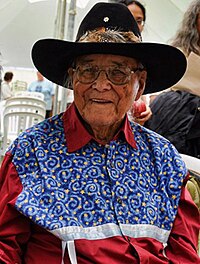William Commanda
| William Commanda | |
|---|---|

William Commanda (by Carol Noel)
|
|
| Born |
November 11, 1913 River Desert Indian Reserve, Quebec, Canada |
| Died | August 3, 2011 (aged 97) Kitigàn-Zìbì, Quebec, Canada |
| Known for | Spiritual leader; band chief 1951–1970; promoter of environmental stewardship |
| Title | Officer of the Order of Canada |
William Commanda OC (November 11, 1913 – August 3, 2011) (Algonquin name: Ojshigkwanàng, normally written Ojigkwanong, meaning "Morning Star") was an Algonquin elder, spiritual leader, and promoter of environmental stewardship. Commanda served as Band Chief of the Kitigàn-zìbì Anishinàbeg First Nation near Maniwaki, Quebec, from 1951 to 1970. In his life, he worked as a guide, a trapper and woodsman, and was a skilled craftsman and artisan who excelled at constructing birch bark canoes. He was Keeper of several Algonquin wampum shell belts, which held records of prophecies, history, treaties and agreements. In 2008, Commanda was appointed to the rank of officer of the Order of Canada.
Commanda was born on November 11, 1913 in River Desert Indian Reserve (now Kitigàn-Zìbì) to Alonzo and Marie Commanda. His Algonquin name Ojigkwanong (meaning "Morning Star," or more literally "he expels a star") came about as his mother looked out the window of the family's log cabin and saw the morning star shining. Commanda had several notable ancestors, including his grandfather Chief Louizon Commanda, and his great-grandfather Chief Pakinawatik, who in 1854 led his people from Oka, Quebec to Kitigàn-zìbì. Commanda was baptized in a Catholic church eight days after his birth.
His youth was spent in severe poverty and difficulty on the reserve. On one occasion he resorted to hiding in the bush in order to avoided the Canadian Indian residential school system. The Commandas' seven children frequently went hungry, and sources of income were infrequent. For work, William became a master birchbark canoe maker, and also worked in lumber camps. His health, weakened from his years living in poverty, finally began to improve in 1961.
From 1951 to 1970, Commanda served as Band Chief of the Kitigàn-zìbì Anishinàbeg First Nation. In 1970, his community presented him with three sacred wampum belts, precious historical records and artifacts. The three Wampum Belts that were under his care are:
...
Wikipedia
